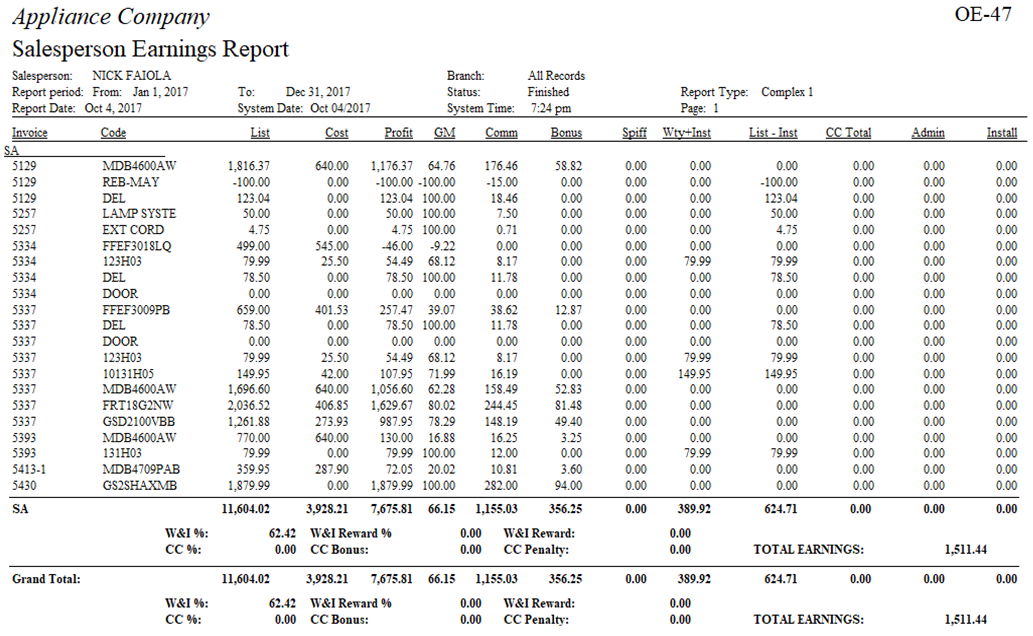Commission Tables
There are 2 ways to setup, use, and calculate commission using EPASS; Commission and Commission Structure.
System Maintenance Tables
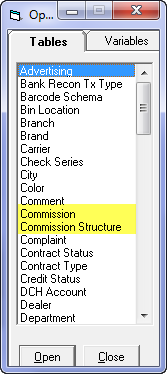
Commission
Commission table is where you name your commission codes. It is a custom way to report, connecting with Crystal Reports, that you currently use to pay commissions but allows for you to select invoice detail lines and determine how they are affected on the Crystal Report.
You select the commission code on the invoice detail line as shown in the snapshot below. It is available on the item, model, labor, misc. and warranty tabs.
To use this feature please call our technical support staff for assistance, unless you are comfortable customizing complex commission Crystal Reports.
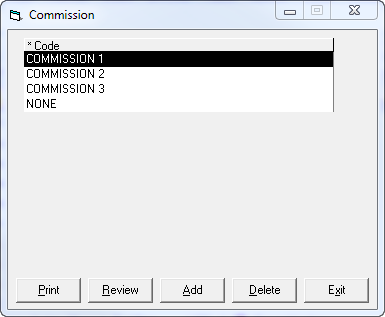

Commission Structure
Commission Structure is a completely supported commission payroll reporting structure within EPASS. This table will allow you to create and define all the rules related to how you calculate commission. You can have as many structures as you want. Each structure can have as many levels as needed.
You can also Copy a commission structure. This enables you to keep your current structure and manipulate the copied version to compare what it would look like if you made a few changes to the current way you pay commissions. It will help you determine how salespeople will be affected if the values/percentages changed.
Once you have the Commission Structure table defined, you also have the ability to report on these structures via the OE-47 Salesperson Earnings Report.
Commission Structure Table
Outside of the full year codes, our example also shows the ability to have a structure in place from Jan 01, 2015 that only ran until June 30, 2015 and a new structure put in place on July 01, 2015 which ran until December 31, 2015.
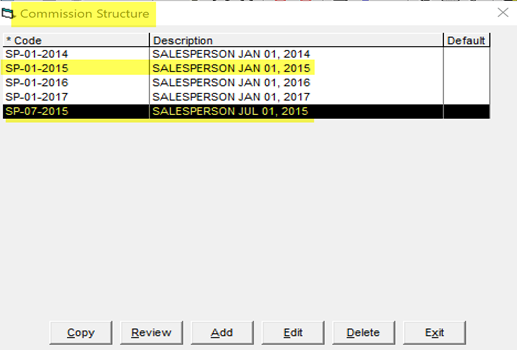
A good way to identify between codes is to create a consistent naming sequence that represents the start date of the commission structure period.
Code and Description: create for each commission structure.
Default Structure: if checked, when running the OE-47, if a salesperson has not had a structure defined to their code, it will use this structure.
GL Code: allows you to identify the GL code you want this structure information to apply to.
Final Bonus: this section is for bonuses on the grand totals for the pay period, which are also referred to as plateaus. You can add as many bonus levels as needed.
Final Bonus Paid on: Ability to select paid on 'profit' or paid on 'list'.
Final Bonus Structure
Sales Goal $: Dollar amount in sales you need to reach in order to get the bonus level.
GM %: Gross margin % you need to reach in order to get the bonus level.
Bonus %: Percentage that is paid in bonus.
Percent of Wty: Ratio of warranty sales over product sales (for example $100 in wty sales and $1000 product sales would be 10%).
Warranty Bonus %: pay this percent if they hit % of wty level.
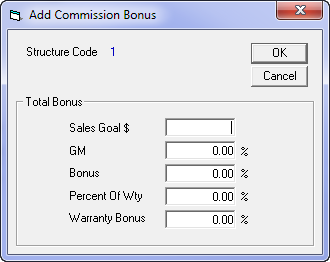
Percent of Bonus Warranty Paid On: you are able to choose if paid on 'profit' or 'list' and, if including model commission, misc., labor, and/or warranty.
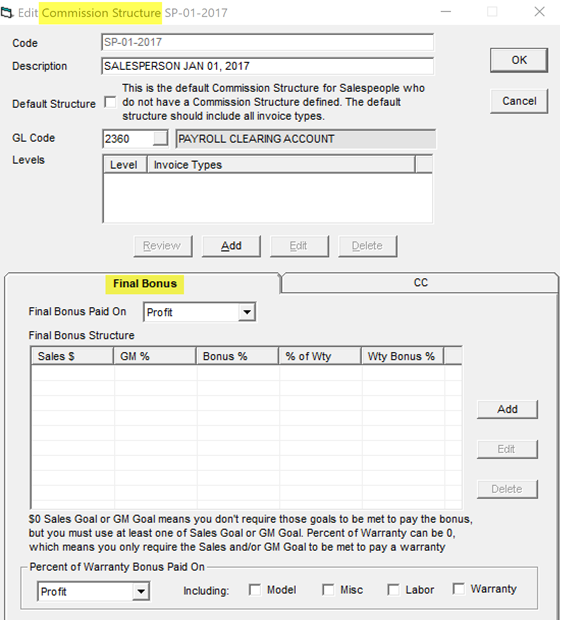
| Sales $ | GM% | Bonus % | % of Wty | Wty Bonus % |
|---|---|---|---|---|
| 0 | 100 | 15 | 4 | 20 |
| 0 | 100 | 15 | 2 | 10 |
| 0 | 18 | 14 | 4 | 20 |
| 0 | 18 | 14 | 2 | 10 |
| 0 | 15 | 13 | 4 | 20 |
| 0 | 15 | 13 | 2 | 10 |
| 0 | 10 | 12 | 4 | 20 |
| 0 | 10 | 12 | 2 | 10 |
| 0 | 8 | 10 | 4 | 20 |
| 0 | 8 | 10 | 2 | 10 |
| 0 | 6 | 6 | 4 | 20 |
| 0 | 6 | 6 | 2 | 10 |
| 0 | 4 | 2 | 0 | 0 |
| 0 | 2 | -0.5 | 0 | 0 |
| 0 | 1 | -0.25 | 0 | 0 |
CC: allows you to determine two options for credit card payment types and how they effect commissions. Bonus and/or penalty levels and percentages, or CC target to applicable sales and bonus percentage.
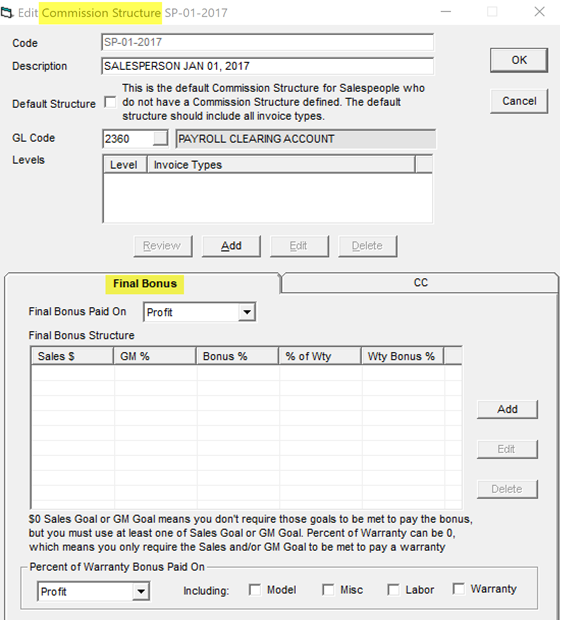
Levels
Each structure can have as many levels as needed. A level allows you to define different rules for a set of invoice types. Once you have selected the invoice types for the level, then you could choose which of the following calculations will be performed, and which values are used.
Structure SP-01-2017 can have 1, 2, 10 levels or more.
Level 1 can be set for invoice types AA, BB, RR, DE and determine the model, misc., labor, and warranty calculations for that level, as well as if this level is included for CC bonus/penalty.
Level 2 is set for invoice types CC, DD, MM, LT, BL, GL and then determine the model, misc., labor, and warranty calculations for that level, as well as if this level is included for CC bonus/penalty.
Model Commission
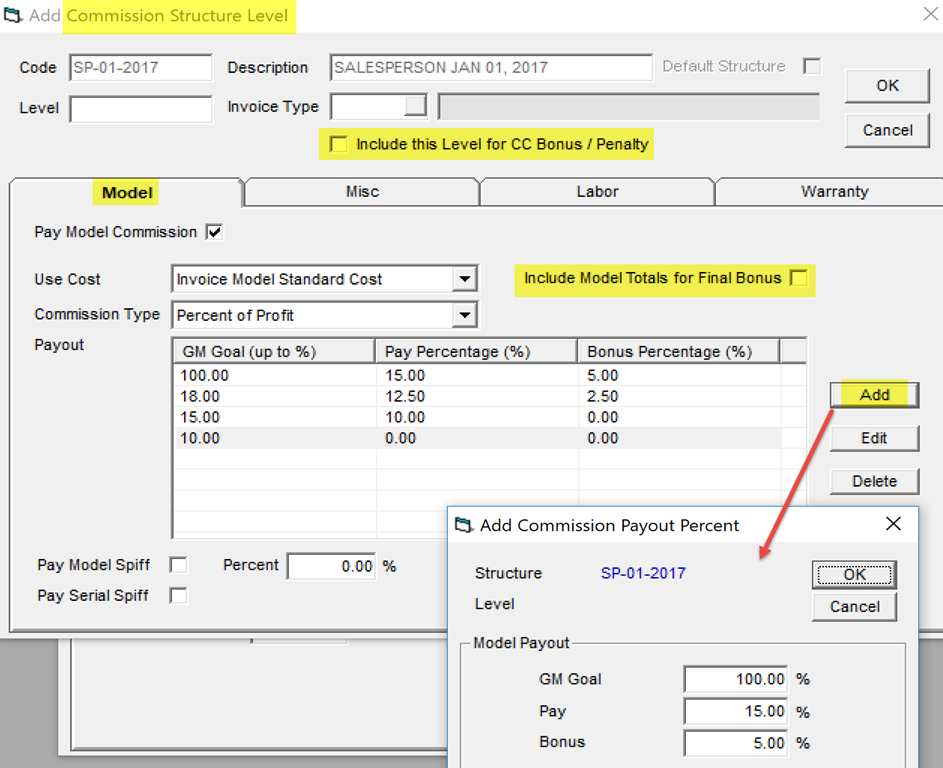
Pay Model Commission: checkbox to determine if we pay on models.
Use Cost: choose from invoice model standard cost, invoice model replacement cost, invoice model landed cost, or invoice model original cost.
Commission Type: select either 'Percent or Profit' or 'Percent of Sell Price'.
Payout: either choose one % which means you always pay this % (either on profit or sell price) or set up a range so depending on the GM% it pays a different %. See above example.
Pay Model Spiff: will pull spiff from invoice model detail line.
Percent: Percentage of the spiff amount that will be paid (if 0.00, it looks back to the spiff on the invoice model detail line and uses that amount).
Pay Serial Spiff: will pull spiff from model in serial inventory. It will check the serial spiff date range.
Misc. Commission
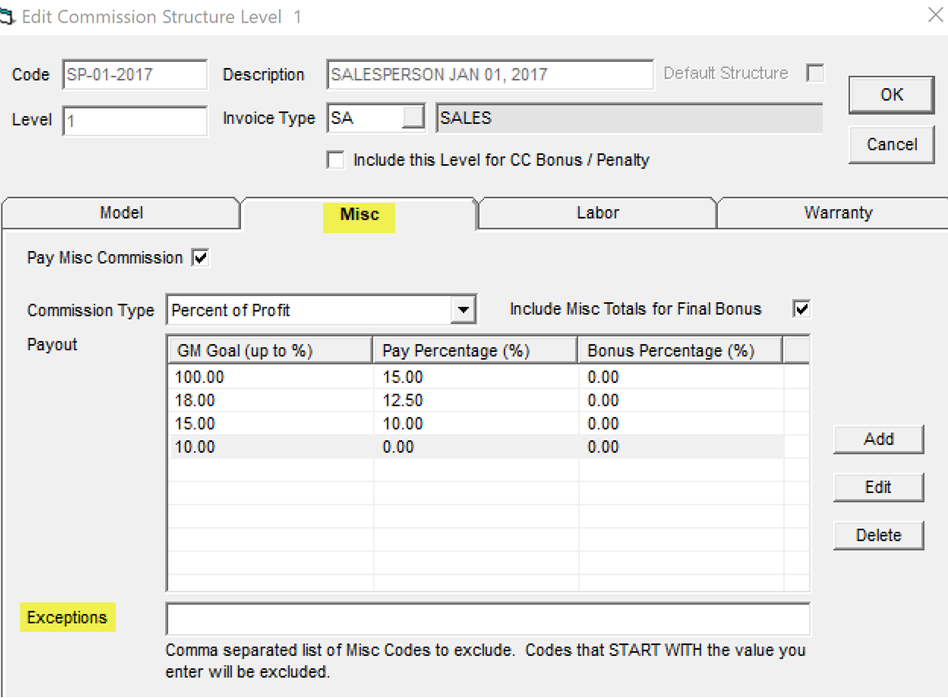
Pay Misc Commission: checkbox to determine if we pay on misc.
Commission Type: select either 'Percent of Profit' or 'Percent of Sell Price'.
Payout: either choose one % which means you always pay this % (either on profit or sell price) or set up a range so depending on the GM% it pays a different %. See above example.
Exceptions: allows you to exclude a list of misc. codes that start with the value you enter. Example: any code that starts with "X-" would be excluded.
Labor Commission

Pay Labor Commission: checkbox to determine if we pay on labor
Use Cost: invoice labor standard cost, invoice labor actual cost, invoice labor cost
Commission Type: select either 'Percent of Profit' or 'Percent of Sell Price'
Payout: either choose one % which means you always pay this % (either on profit or sell price) or set up a range so depending on the GM% it pays a different %. See above example.
Warranty Commission
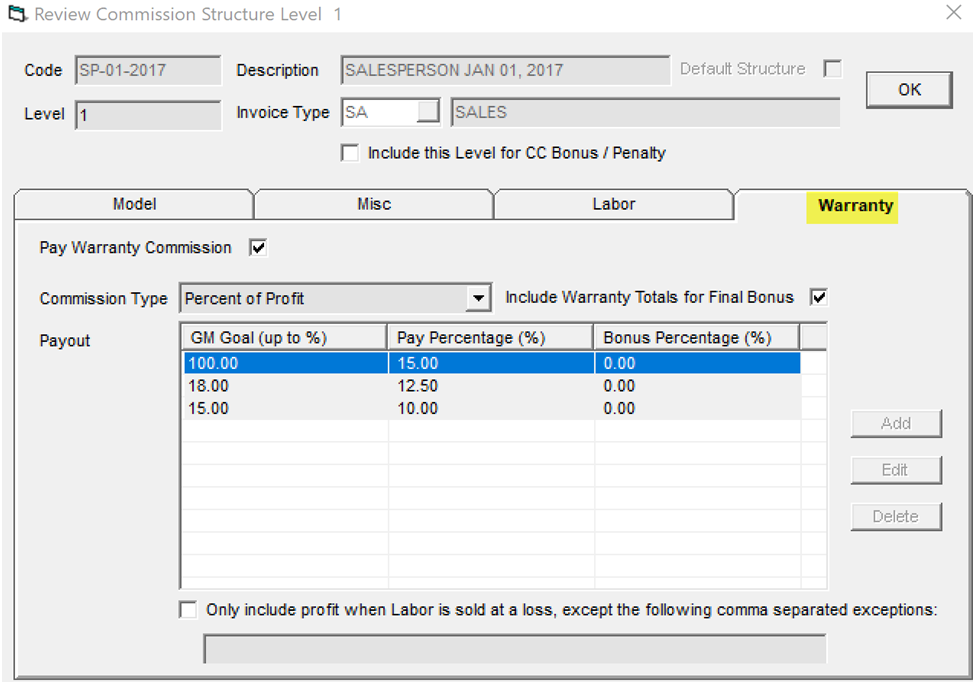
Pay Warranty Commission: checkbox to determine if we pay on misc.
Commission Type: select either 'Percent of Profit' or 'Percent of Sell Price'
Payout: either choose one % which means you always pay this % (either on profit or sell price) or set up a range so depending on the GM% it pays a different %. See above example.
Salesperson Table
You have the ability to track which commission structure the salesperson belongs to. You enter the date range related to each structure so you can historically track which structure they belonged to at which time.
Example: From the date range 2017-01-01 to 2017-12-31 they belong to SP-01-2017

You will notice that salesperson MC belonged to a commission structure SP-01-2014 for all of 2014; however, appears that they left the company and came back on October 01, 2015 which falls into the SP-07-2015 structure, then remains with the company to current.
This allows to track commission structures for salespeople with great flexibility. You can have an unlimited number of structures based on however you want to group them, as well as any structure can belong to any pay period. A salesperson can easily switch structures in the middle of a pay period, if needed. It also allows the company to make commission changes mid way throughout a year and continue to easily track salesperson commission calculations from one structure to another.

OE–47 Salesperson Earnings Report
This report gives the ability for managers, salespeople and payroll staff to run the commission report based on the security level they have and to run it for finished and/or open invoice status.
System Maintenance Security

If the user has any of the first three, they'll be able to run the report in some form. If they do not have the fourth, it will force them to sign in again when they try to run the report. If user A was signed in, then user B sat down to run the report, it will force the sign-in, load all of B's settings, then open the report with those credentials.
For Everyone: if you have this security, the user is able to run the report without any restrictions. Security at the highest level usually set, for example, to a payroll user, regional sales manager, or accounting department users.
For My Branch: if you have this security, then the salesperson drop down will be filtered to only show salespeople in that user's branch, and branch will be locked so even if they run it for ALL salespeople, it will still only show salespeople from their branch, but it will include sales that their salespeople had in another branch. This way it keeps everything under the primary branch, and the numbers will match up compared to other grouping options.
Typically a store manager would have this security. It will take their user salesperson code, read their salesperson code table to determine the branch they belong to, then will find all salesperson codes with the same branch and filter the report to only show them those salespeople.
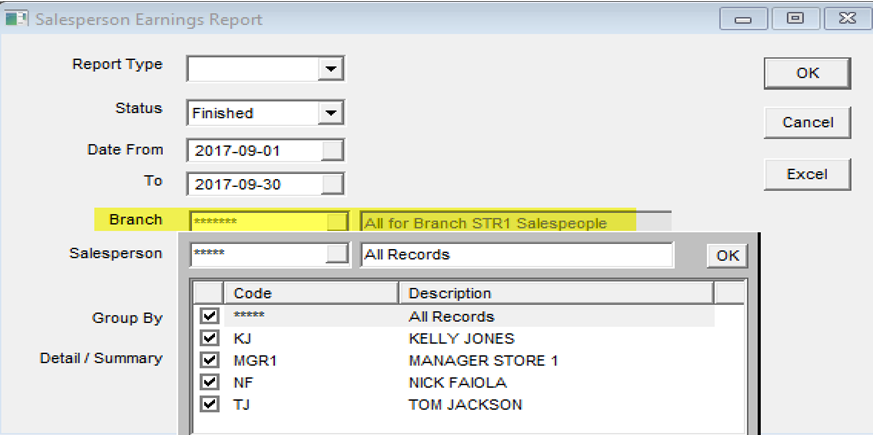
When the store manager logs in with their security, the OE-47 knows to auto populate with only the salespeople within the store manager's branch. They can then run for 'all' or an 'individual' salesperson code, but will only be able to select from their specific branch salesperson codes.
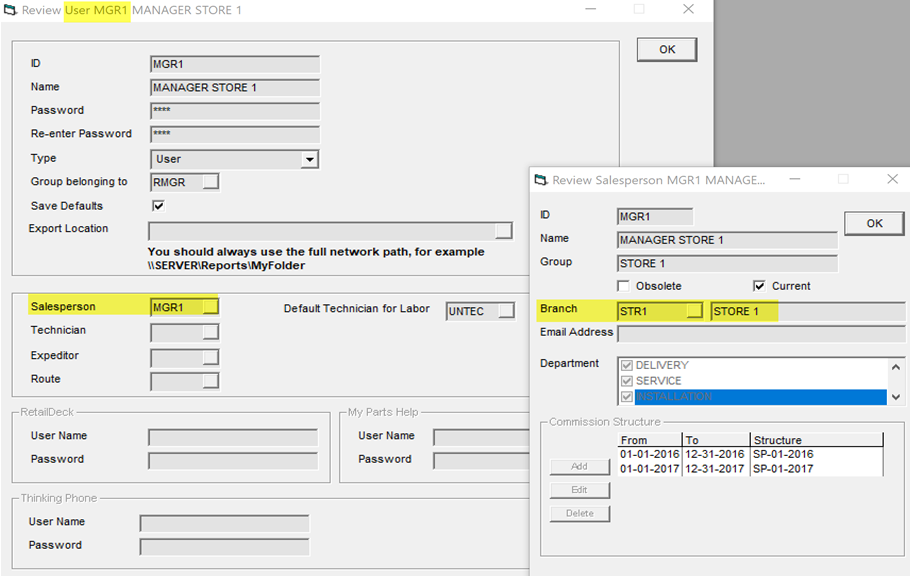
For Me Only: if the user has this security, then branch is locked to ALL as above and salesperson is set to themselves and locked so they can't change it. It will pull up all of their sales regardless of branch. Group By also locks to Invoice Type option only.
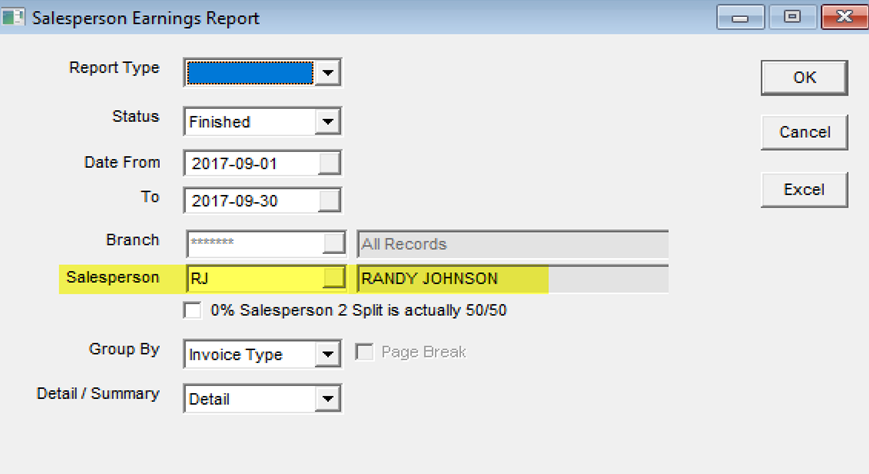
Report Options
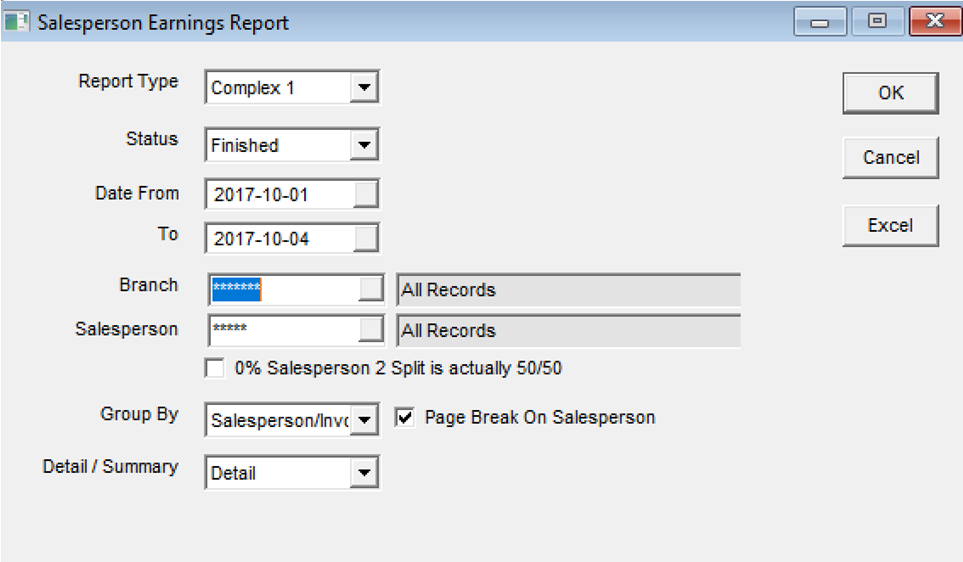
Report Type: Complex 1 is a standard report type that can be used by anyone. Other than Complex 1, a customized report type version can be programmed to suit your company's needs.
Status: you can run the report on 'Finished' or 'Open' status. Finished is most commonly used for paying commissions.
Open is used as a sales tool to see what they have open in a view that represents how it would look if finished. Now, they can also select to run by Schedule/Pickup Date, Invoice Start Date or if you want to include blank schedule/pickup date invoices.

Date From & To: if the status is finished, then pull all invoices that are finished within this date range. If status is open, then pull all open invoices based on the Type (Schedule/Pickup Date or Invoice Start Date).
Branch: select the branch you want to run the report for, or for ALL branches, based on your user security.
Salesperson: select the salesperson you want to run the report for, or for ALL records, based on your user security.
You also have the checkbox option '0% Salesperson 2 Split is actually 50/50'. Only check this if you want anywhere salesperson 2 currently shows 0% to equal 50% when running the report.
Group By: options to group by are Invoice Type, Salesperson/Branch, Salesperson/Invoice, GL/Salesperson, and Salesperson. These groupings are only available to all users except if security is set to 'Only for Me'.
Grouping by Salesperson is a specific layout most commonly used by someone in the payroll department.
Detail/Summary: option to select to run the report in detail or summary.
Complex 1 Report Layout Example
